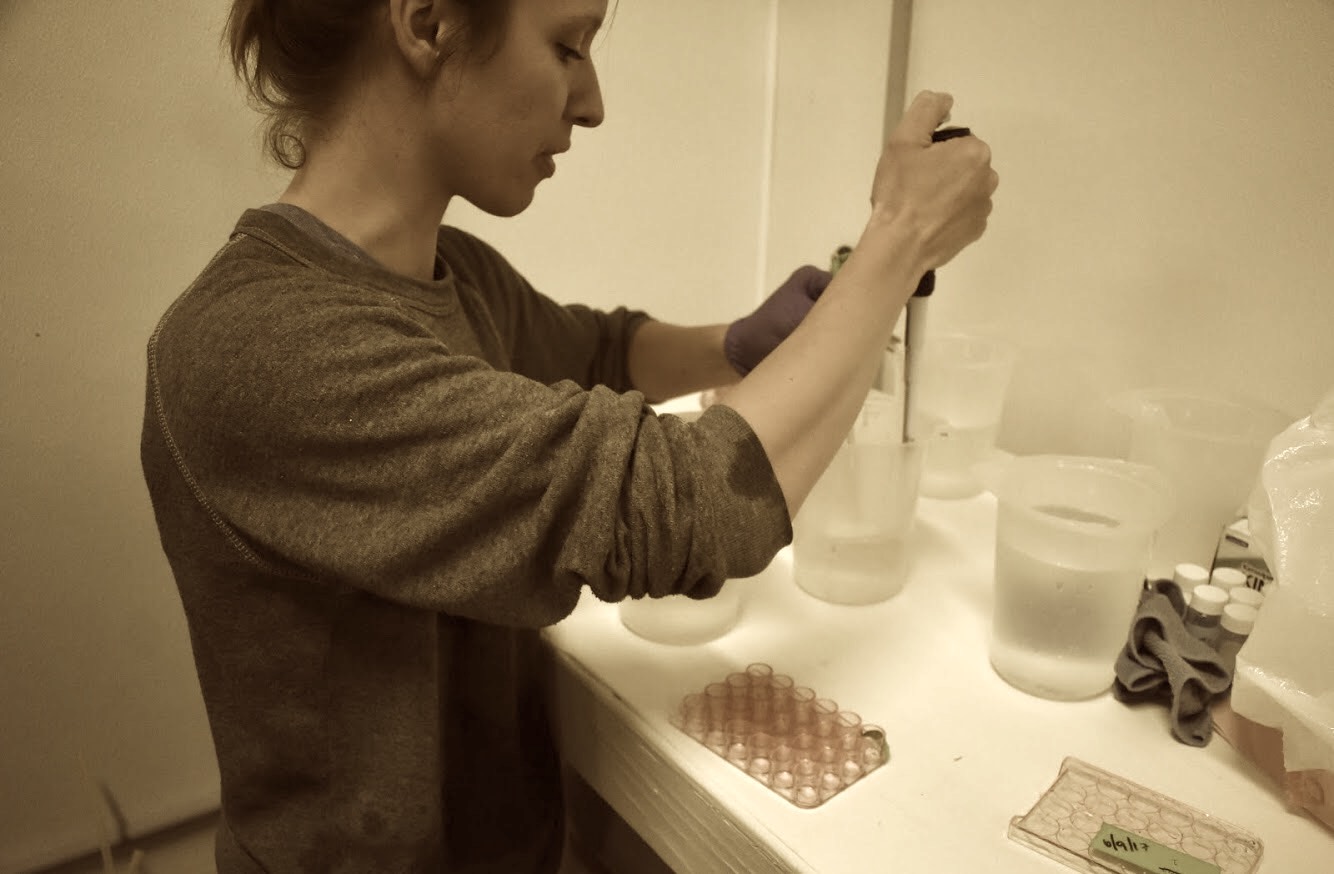May 21st 2017
Arrival Inspection
- Aeration @ larval table not working; turned airstones up and that worked, so somehow the airline on the larval table lost some pressure overnight.
- Valves 6, 7 & 8 on the bottom shelf’s manifold the larval table consistently bubbling from air in the FSW line, other buckets don’t have the same bubbling.
- Banjos moderately dirty, not clogged though
- K-10 amb larval dripper clocked, bucket only 1/2 full
- Larvae present in catchment buckets:
- K-6 amb: a bit
- SN-6 low B: a lot
- SN-6 low A: a lot
- SN-10 amb A: a lot
- SN-10 amb B: a lot
- NF-10 low B: a lot
Tasks Today:
- Measured volume actually in 5 gal bucket with banjos: 15 L = 4 gallons
- Stocking density (as per PSRF / FAO manual): 1 larva/mL for 1 tank turnover/day
- (24 hrs / (Tank Vol (L) / (flow rate)))1 larvae/mLTank Vol (L) * 1000mL/L = # larvae/mL to stock in bucket
- e.g. (24hrs/(15L/8 L/hr))*1 larva/mL * 15 L * 1000 mL/L = 192,000 larvae. I’m going to round up to 200,000 larvae
- Imaged larvae collected 5/19 & 5/20
- Counted larvae collected 5/20
- Plumbed in new algae input for broodstock.
- I have noticed that the water color on the top shelf on the broodstock table is light. I’m thinking that, because the algae injection point is very close to where the pipe splits, the algae could be “channeling” to the bottom shelf.
- Cut the 1/2 pipe ~3 feet back from the current injection point; glued in new 1/2” threaded coupler. Let dry for ~1 hour. Flushed for ~45 minutes post gluing.
- The same issue may be happening on the larval table; there isn’t pipe available to plum in new injection point. Researched mixing valve/connection for larval line, but I didn’t find one. Need to chat with Stuart. Could just use Y’s to only use 4 middle valves and split them
- Cleaned all banjos
- Fed with live algae:
- Used 1/2 Tiso/Ciso mix + CGW
- Completed top shelf of larval table: g
- Got new banjos finished and installed on the top shelf of the larval table
- Replaced drippers on all lines
- Replaced air stones as needed
- Screened new larvae, sampled for counting & imaging
- Screened new larvae through 200um screen onto sorting table filled w/ FSW
- Placed 2x100um screens under sorting table- top one clean and vortexed
- Drained sorting table onto 100um screen
- Soaked larvae in freshwater @ 18degC for ~1 minute.
- Collected larvae in tripour filled to 800mL for dense amounts, and to 250mL for small amounts. Labeled with tape, left on bench while I collected the other groups
- Vortexed sorting table & screens between groups
- Sampled triplicates from each group; counted 1 well only for stocking purposes. Fixed all wells with Lugols for counting tomorrow.
- Stocked larval buckets:
- Some groups that were already fully stocked on the bottom shelf spawned today, so I decided to use the top shelf of larval rearing table. This Tuesday when I screen/size/count I can either 1) separate out 2 size classes (e.g. <160um, >160um) and add new larvae to the small size class bucket until full, or 2) combine larvae from both buckets, save 200k max for one bucket, then use the empty bucket for new round of larvae. This will depend on how the larvae grow and the mortality.
- Sketched out a method to stock buckets gradually.
- As per PSRF, only clean/screen larvae 2x per week to minimize handling, e.g. on Tuesdays/Fridays: screen on Tuesday to size & count; then use the following calculation:
- (200,000 - # larvae stocked on Tuesday) / 3 days until Friday = # larvae to stock on Tuesday afternoon, Wed, & Thurs.
- E.g. stock ~50k per day on Fri, Sat, Sun & Mon for a total of 200k, then on Tuesday screen, count, and take stock of what’s left.
- As per PSRF, only clean/screen larvae 2x per week to minimize handling, e.g. on Tuesdays/Fridays: screen on Tuesday to size & count; then use the following calculation:
- To measure out volume needed from each group, I used plunger to mix while simultaneously pouring into separate tripour to desired vol.
To Do tomorrow:
- Measure dripper rate @ larval tank.
- Make connection for freshwater
- Collect new larvae, sample, count, stock
- Determine how I should collect larval samples, and how frequently
- Determine if I should fix larval samples in formalin moving forward as opposed to Lugols. Lugols dyes the larvae dark, so it’s not possible to decipher between live & dead. It’s helpful for counting & (I would imagine) imaging purposes, though. Ask Rhonda/Grace what was used on gigas larvae.
Written on May 21, 2017
